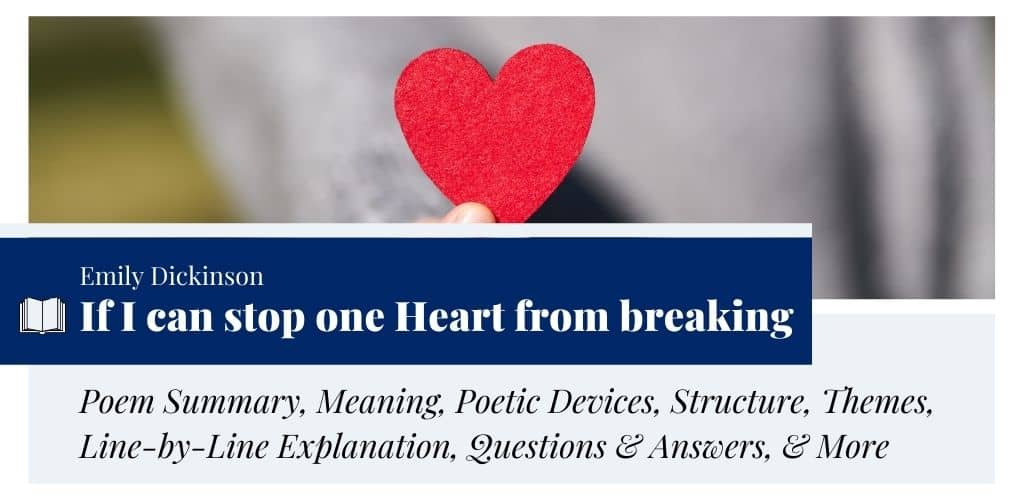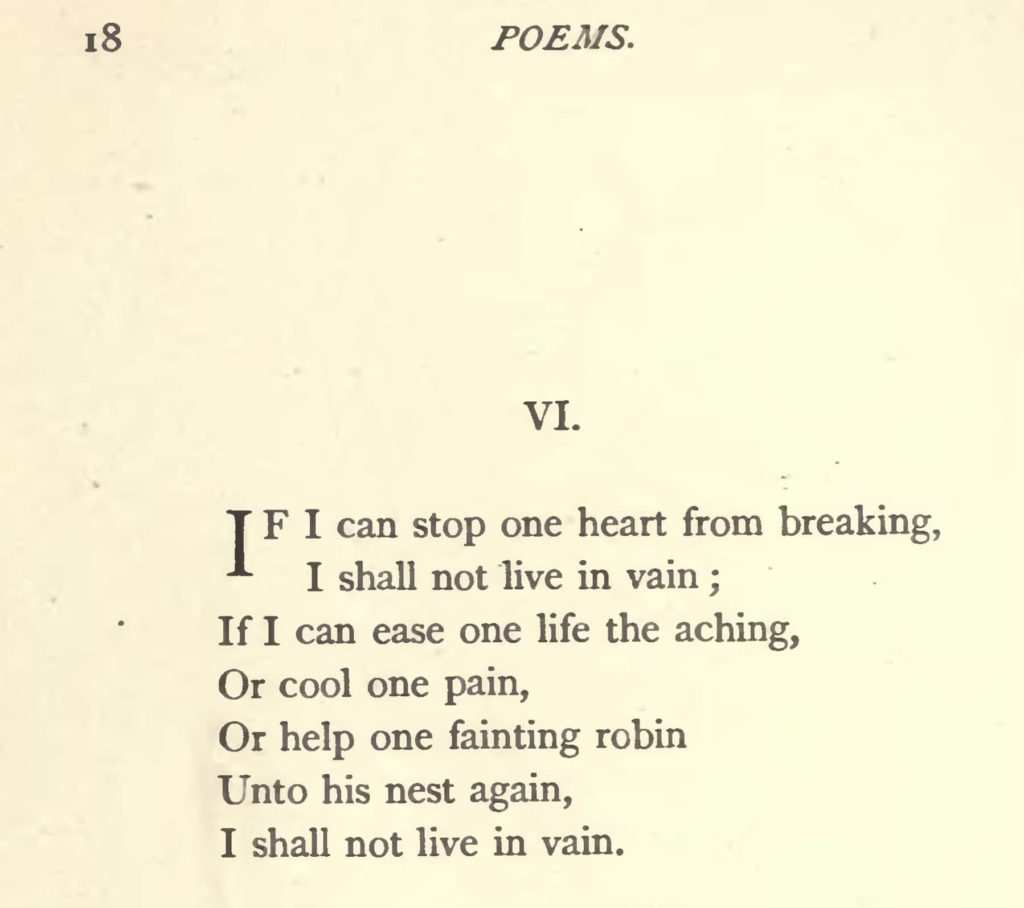If I can stop one Heart from breaking by Emily Dickinson
“If I can stop one Heart from breaking” is a short and straightforward poem written by one of the most remarkable American poets ever, Emily Dickinson. This poem does not become incredible only for Dickinson tag. It has such philosophical and spiritual depth that goes beyond the apparent utilitarian meaning of helping others. This piece raises a probing question: “How much could be done to alleviate the suffering of humankind?” When Siddhartha was struck by the same question, he transformed into Gautama Buddha. So, does Dickinson propose asceticism as a solution? Does she really want to go beyond her mortal limitations and “ease” the unending “Aching” of humankind?
This poem raises such interesting questions right from the beginning, from the usage of the word “If” to the repetition of “one.” Even the image or symbol of a regular Robin becomes essential with respect to the subject matter of the poem. Overall, through this momentary lyric, Dickinson conveys her earnest wish to comfort someone, thereby giving her life a purpose. It was written around 1864 and first published posthumously in the collection Poems (1890). The actual version of the text first appeared as poem number 919 in The Complete Poems of Emily Dickinson by Thomas H. Johnson in 1955.
- Read the full poem “If I can stop one Heart from breaking” below:
If I can stop one Heart from breaking (919) by Emily Dickinson If I can stop one Heart from breaking I shall not live in vain If I can ease one Life the Aching Or cool one Pain Or help one fainting Robin Unto his Nest again I shall not live in Vain. - from The Complete Poems of Emily Dickinson (1955)

Summary
In “If I can stop one Heart from breaking,” Dickinson expresses her earnest desire to help someone out of their misery. She feels that being there for only “one” individual will give her life a purpose. Thus she shall not waste it. Lending someone a helping hand will make her life worthwhile. Therefore, she wishes to soothe someone’s aching heart and give them solace and comfort.
In the second stanza, she expresses her desire to help a “fainting Robin” by taking it to its “Nest.” The “fainting Robin” could be a reference to a person experiencing heartbreak and has become weary. The speaker wants to lift the spirit of that person who is going through a tough time. Being selfless and kind will not only help someone recover but also make her own life better and more meaningful.
Meaning
The poem “If I can stop one Heart from breaking” begins with an argument that leads readers to think about what drove Dickinson to say so. It is worth considering the thoughts that could have been there in her mind before proposing this argument. A deeper look at the definitive use of “one Heart” will lead to another argument the poet might be thinking about: it is not possible to ease or give relief to each human being out of their suffering, heartache, and illness. Therefore, what should be the best way to contribute to humanity without being bogged down by our limitations? According to Dickinson, if one can stop only one individual teeming on the verge of mental collapse or assist one hurt Robin lying somewhere unnoticed, they shall not live in “Vain.”
Form, Rhyme Scheme, & Meter
Structure & Form
“If I can stop one Heart from breaking” is a lyric poem consisting of seven lines that are divided into two stanzas: one quatrain and one tercet. The poem follows a somewhat regular rhyme scheme and metrical pattern. It is written in the first person, denoted by the use of the pronoun “I.” Unlike Dickinson’s other poems, this poem does not have her trademark dashes or metrical pauses (commas in between the lines). However, readers can find the use or capitalizations in each line, such as in the first line, the first letter of “Heart” is capital. The 1890 version of the text contains commas at the end of lines one, three, four, and six that Dickinson did not intend to use.

Rhyme Scheme
The overall rhyme scheme of “If I can stop one Heart from breaking” is ABAB BBB. It means in the first quatrain, the first and third and the second and fourth lines end with similar rhymes:
- “breaking” and “Aching”
- “vain” and “Pain”
In the tercet, the last two lines follow the same rhyme used in lines two and four. While the fifth line, ending with “Robin,” loosely rhymes with “again” and “Vain.” It is an instance of slant rhyme, another important poetic technique used by Dickinson.
Meter
Dickinson composed this poem in the iambic meter. The first and third lines are in iambic tetrameter; the fourth line is in iambic dimeter; the rest is in iambic trimeter. Therefore, it can be said that the overall or major meter is iambic trimeter. In an iamb or iambic foot, an unstressed syllable is followed by a stressed syllable. Let’s have a look at the scansion of the poem that will give a better idea of the metrical scheme:
If I/ can stop/ one Heart/ from break(i)ng
I shall/ not live/ in vain
If I/ can ease/ one Life/ the Ach(i)ng
Or cool/ one Pain
Or help/ one faint/-ing Rob(i)n
Un-to/ his Nest/ a-gain
I shall/ not live/ in Vain.
As we can see, Dickinson uses elision in the last syllable of lines one, three, and five. For the clipping of the vowel in “Robin,” it sounds similar to “vain” and “Pain” in the previous lines. After reading the scanned lines with proper stress on the desired words/syllables, one can understand how the rising rhythm of an iamb influences the mood of the poem. As this poem responds to a skeptical argument, the sound of each line should be uplifting, resonating with Dickinson’s optimistic points.
Poetic Devices & Figures of Speech
Alliteration
The usage of alliteration in “If I can stop one Heart from breaking” can be found in a number of instances. The general alliteration does not occur in the text. However, its types, consonance, and assonance occur in the poem. As the poet uses regular end rhymes, she preferred not using the repetition of similar sounds at the beginning of neighboring words to create internal rhyming.
Consonance
It’s the repetition of similar consonant sounds in closely placed words. It can be found in the following instances:
- “I shall not live in vain”
- “If I can ease one Life Aching”
- “one Pain”
- “one fainting Robin”
- “Nest again”
- “I shall not live in Vain.”
Assonance
Assonance is the recurrence of a similar vowel sound in close proximity. It occurs in the phrase, “live in vain.” The “i” sound is repeated here.
Metaphor
Dickinson uses a metaphor in the first line of the poem, where she compares “Heart” to a material that can be broken. It is a figurative way of describing the emotional breakdown. In the fourth line, she says, “Or cool one Pain”. The abstract idea of “Pain” is compared to an excited or hot object.
In the tercet, the “Robin” and “Nest” are extended metaphors for human beings and comfort/safety, respectively.
Personification
The use of capitalization in “Heart,” “Life,” “Pain,” and “Robin” hints at the fact that these ideas are personified. Firstly, the poet personifies the organ heart and invests it with the idea of emotionally breaking down. She presents the abstract ideas of “Life” and “Pain” as individuals. Furthermore, the “Robin” represents humans, and thus, in a way, it is also personified. Dickinson invests the bird with the human act of fainting.
Repetition
Dickinson repeats the line “I shall not live in vain” twice in the poem. It emphasizes the idea that helping and being kind to someone will not let her life go in vain. Besides, there is a repetition of the term “one” in lines one, three, four, and five. The speaker describes that if she can help only “one” individual, her life will be fulfilled. She knows she cannot help each and every human being in grief. That does not mean she should just sit and watch others suffer. Therefore, a practical solution to this big problem is taking small yet effective steps by helping those who are around us, suffering or need our help. To highlight this idea, Dickinson repeats the term “one.”
Anaphora
Anaphora is the recurrence of a word or phrase at the beginning of consecutive lines, phrases, or clauses. Dickinson uses this device in lines four and five. They begin with the word “Or.” The speaker repeats this word to emphasize her desperation to be of help to someone.
Or cool one Pain
Or help one fainting Robin
Enjambment
It is interesting to note that the poem “If I can stop one Heart from breaking” consists of a single sentence, with a combination of clauses fused together by the use of enjambment. One can notice only one full stop is used at the end. Firstly, Dickinson enjambs lines 1-2 to present the main idea. Then, she elaborates on her other arguments by connecting them internally, ending with the closing statement, “I shall not live in Vain.”
If I can ease one Life the Aching
Or cool one Pain
Or help one fainting Robin
Unto his Nest again
I shall not live in Vain.
Line-by-Line Explanation & Analysis
Lines 1-2
If I can stop one Heart from breaking
I shall not live in vain
The first two lines establish the central theme of the poem, helping someone from suffering heartbreak. These lines convey the speaker’s willingness to protect someone from anguish. She wants to positively impact someone’s life as it would not only bring solace to that individual but also make her life worthwhile. From her desire to help others selflessly, one can also perceive a tinge of pain in her own heart; she wants to help others as it would eventually reduce her heartache to some extent.
Whenever a person undergoes pain or mental suffering, they can feel/realize the suffering of another individual going through a similar condition. The past experience helps the speaker understand others’ pain better; she can empathize with them by placing herself in their place. Besides, she wants to be of use somehow. She does not want to sit idly with the thought of what “one” human could possibly do to alleviate the suffering of several living beings (not limited to humanity). This skeptical thought drives her to choose a realistic course of action, reflected in her wish of helping “one” first.
The poem begins with a direct argument without providing a proper ground, following which the speaker has come to this conclusion. Reading her argument (in lines 1-2) at face value would lead us to the conclusion that the heartbroken speaker has probably been thinking about assisting one suffering from heartache. It could be “one” possible dedication. The speaker could have been desperate as she could not make things right in her past. She is desperate as she has failed to be there for those she loves.
So does that mean she is useless, her existence does not matter at all? She answers this cynical view about oneself as “useless” and “worthless” by saying that she will be of use to others in the short time she has on earth. She will not sit idly like before engrossed with the thoughts of her mortal limitations. Hence, she is determined to do something meaningful, practical, and effective. In this way, her life will not be in vain.
Lines 3-4
If I can ease one Life the Aching
Or cool one Pain
These lines of “If I can stop one Heart from breaking” build upon the argument of the first two lines. The speaker’s expression of providing consolation to someone in successive lines makes her desperation to be impactful in someone’s life more evident. She wants nothing more than wanting to lessen someone’s suffering and get them out of their misery. Alongside that, she wants to cool the “Pain” of someone in despair.
In the first line, Dickinson capitalizes the word “Heart” for the sake of emphasis. She follows the same scheme in words, “Life,” “Aching,” and “Pain.” Besides, there is a repetition of the “one” in these lines. The usage of a definitive cardinal number makes her argument sound firm and practical. Dickinson’s speaker is not hyperbolic about her course of actions. She could be emotionally unstable, but her reasoning is not. No matter how broken she is, she can devise a humanitarian plan comprising a practical course of action. Her focus is on the realistic approach of solving things by starting from little.
“Aching” vs. “Pain”
Readers may think that “Aching” and “Pain” are synonymous. Then why does the poet use words with a similar meaning twice? In linguistics, if two words have exactly the same meaning, only one of them would have existed. If the two words have been in existence for a long time, it means there is a slight difference in the usage or meaning. “Aching” is related to a more intense kind of mental suffering. In contrast, “Pain” is more about the bodily suffering arising from an illness. This term broadly captures any pain related to the human body. If that pain exists for an extended period, it gradually weakens one heart and will.
Therefore, through these lines, the speaker wants to not only reduce the “Aching” of one’s life but also hope to assist them suffering from physical pain. One can literally “cool” or alleviate the physical pain by providing them care and proper medications. But, life’s “Aching” can only be eased, not erased. What does the poet actually do to ease others’ life-ache? She writes such enlightening poetry! Indeed, her poems have the ability to heal and revamp the way we think.
Lines 5-7
Or help one fainting Robin
Unto his Nest again
I shall not live in Vain.
A primary reading of these lines makes readers think the speaker desires to comfort fainting “Robin” (a small Old World thrush) and help it by taking it back to its “Nest.” But, the “fainting Robin” is an extended metaphor for a person who is weary and exhausted because of agony. As long as she is helping a person by lifting their spirits, her life will not be in vain.
These lines sound so simple that they naturally raise readers’ eyebrows; it makes them think how these lines could sound so sweet though they capture a grave idea. Dickinson is not famous only for her peculiarities. She still wins hearts for her ability to capture such exceptional ideas through simple words; just a tweak here, the whole shape transforms into a more magnificent idea.
The “Robin” and the “Nest”: Concept of Rejuvenation
To understand the inner meaning of this argument, readers have to focus on each and every word in the line “Unto his Nest again”. Firstly, unto is an archaic term used while referring to a particular direction in time and space. The word “his” is used to personify the songbird. It is also important to note that only the male robins can sing. They have complex vocalizations and can sing different notes. Isn’t this quality relatable to Dickinson’s poems?
Then comes the symbolic “Nest,” indicating a number of ideas: comfort, safety, or even heaven. Lastly, the term “again” refers to a continuous cycle. It could be a reference to the cycle of birth and death.
Returning to the main clause, “Or help one fainting Robin,” readers can now understand that “Robin” represents humanity. Besides, the epithet “fainting” is used to refer to someone gradually weakening. The term “one” is used to denote humankind in general, not a single person.
Sometimes people suffer from an ailment or disease that cannot be healed. It becomes impossible to stop the gradual deterioration of their health and mental strength. So, what could be done in this scenario? According to the poet, it is better to be there for the person and cheer them up, even though it seems meaningless. It would be a great relief in their journey to the “Nest” that rhymes with the word “rest.” Only the final rest could ease their pain. In this way, Dickinson portrays how death could sometimes be relieving. Besides, death is not an end. When finally one goes back to the “Nest,” it helps the soul come “again” in a fresh attire.
Begin with a Little Robin
These lines can also be interpreted differently. The speaker wants to take a leap to help humankind with all her might. But, she must not think only about the big picture. Often, a little Robin lying somewhere unnoticed, wounded and growing weak. Helping the creature out of its misery is also a service, not unimportant.
Inspiring the “Robin” Within
If we take the word “Robin” as a symbol of hope and faith, the meaning of the lines takes another shape. Through this argument, the speaker talks about inspiring a person whose hope is about to evaporate, whose will is on the verge of collapse. She wants to help that individual by recharging their weakening hope, sickening soul and deteriorating mental strength.
Dickinson uses the refrain in the last line, but with a slight modification of the word “Vain.” This time she wants to put more emphasis on her argument as well as on this particular term. As she closes her argument, she needs to voice the main idea, which is not living in vain. The literary device litotes (an ironic statement in which an affirmative idea is hinted at by the negative of its contrary idea) also serves this purpose. It is used to highlight the actual statement, “My life will be meaningful.”
Themes
Emily Dickinson’s “If I can stop one Heart from breaking” explores a number of themes that include the purpose in life, compassion, and empathy, human limitations versus optimistic thinking, selflessness, rebirth, and humanity. The main themes of the poem are exemplified below:
Finding a Purpose in Life
Humans are in the constant pursuit of finding a purpose in life, thus giving their life meaning. People want to leave an impact somehow and make their lives worthwhile for others. Dickinson lived most of her life in seclusion and had minimal contact with the outside world. She expressed herself and her feelings through poetry. Her only desire in life was to be helpful to someone and ease their pain.
According to Dickinson, the true purpose of her life is to be compassionate to someone and help someone come out of their agony, “Aching,” or “Pain.” The one way one can make an impact is by being kind and helpful to others, healing someone’s ailing mind, and by consoling someone with a broken heart. In this way, Dickinson explores the theme of finding life’s true goal from a humanitarian perspective.
Compassion & Empathy
Through “If I can stop one Heart from breaking,” Dickinson conveys the message of being compassionate and showing empathy to others. She believes that compassion and empathy will not only help others but also heal her own life and give her a sense of fulfillment. Human life is full of struggle and misery. Being there for one another is the only way one can make the world a better place. The speaker’s message is not limited to reaching out to people in their need. It also includes other living creatures, such as birds and animals.
Limitations vs. Optimism
With due regards to her limitations as a human being, Dickinson proposes a practical solution in the poem. She does not want to be a cynic, questioning and refuting the underlying optimism in the human heart. The awareness of the suffering and pain of humankind on a large scale makes her proactive. She somehow wants to contribute, not considering whether her contribution is going to make any significant impact. As long as she can ease one’s ache or heal one’s fitful fever, she will find herself fulfilled. If she is there for a person who is about to die and can cheer them up in their final moments, her life will not be meaningless. In this way, she refutes cynicism arising from one’s mortal limitations with sheer optimism and practicality.
Symbolism
The use of symbolism in “If I can stop one Heart from breaking” can be found in words “Robin” and “Nest.” The “Robin,” which usually is a cheerful songbird, is tired and fainting. The speaker is empathetic towards the creature and wants to put it to rest in its “Nest.” Thus through the symbol of a “fainting Robin,” she describes the adversities people face that affect their morale. Agony drags them to the ground. They badly need someone lending them a helping hand. It will help them to put their miseries in the past and move on with life.
The “Nest” of the “Robin” is a symbol of safety and comfort. So using this symbol, the poet desires to take the person out of their suffering and make them feel safe. The “Robin” is also a symbol of spring. Thus, it hints at the ideas of hope, inspiration, and rebirth. So, by helping a “Robin” to reach unto its “Nest,” the poet talks about boosting one’s morale. Apart from that, in the first line, the “Heart” stands for emotions.
Imagery
Dickinson uses vivid imagery to evoke similar feelings in the readers. In the first three lines, she uses organic imagery to convey the feelings of heartache and intense sorrow. The image of a “fainting Robin” also evokes a sense of pity in readers’ hearts. In the fourth line, the phrase “cool one Pain,” is an example of tactile imagery. This image leads readers up to the extended metaphor of a person’s bodily pain. The speaker wants to “cool” or lessen their physical suffering. The visual image of a “fainting Robin” taken to its “Nest” can make us realize the satisfaction the speaker gets after helping the creature. In a way, these lines also showcase the use of organic imagery.
Tone & Mood
The tone of the poem “If I can stop one Heart from breaking” is empathetic, kind, and compassionate. There is a sense of urgency and confidence in the speaker’s voice/tone. She is empathetic to people suffering from heartbreak and pain. She wants to put an end to their suffering by being kind and helpful. In fact, her heart aches to be beneficial to someone and impact others’ lives positively. The tone also influences the mood of this piece. Dickinson’s confidence creates an optimistic mood throughout the poem. The images of cooling one’s pain and putting a Robin to rest – create a soothing and fulfilling mood.
Historical Context
Emily Dickinson, along with Walt Whitman, is considered the most influential literary figure of 19th-century America. Dickinson lived all her life in seclusion. She mostly communicated with her friends through letters. She expressed herself in her poems and maintained limited contact with society. Unlike other poets of her era, she broke away from the conventional form of poetry and experimented with different styles. Many of her poems dealt with macabre themes like death and immorality, while some explored themes such as aesthetics, nature, and spirituality.
Dickinson was not recognized during her lifetime as only 10 of around 1,800 were published when she was alive. It was after her death in 1886 that her sister Lavinia discovered her treasured poems and published them thereafter. Her first collection, Poems, was published in 1890. The poem “If I can stop one Heart from breaking” was published in this collection and appeared as the sixth poem of the first section entitled “Life” (Book I). Johnson, in The Complete Poems of Emily Dickinson (1955), dated the poem 1864 and numbered 919. 1861-1865 was the most fruitful period in Dickinson’s poetic career. Dickinson wrote over 800 poems and developed her themes of nature, life, and mortality during this period.
Questions and Answers
“If I can stop one Heart from breaking” (919) by Emily Dickinson is about the poet’s wish to help one individual in their need in order to give meaning to her own life. She creates a win-win situation for both herself and the person or any living creature. By helping others, she will be helping herself in finding a meaning, a purpose in her life. As described in her poem “The Heart asks Pleasure—first—” an individual needs pleasure or some sort of relief from the onslaught of grief and crucifying pain. As she herself understands the effect of pain on the mind as well as on health, she tries to “ease” one’s “Aching” or “cool” one’s pain.
“If I can stop one Heart from breaking” orbits around the theme of compassion and empathy. It also explores the themes of suffering, humanity, purpose, and limitations vs. hope. In this poem, she describes how showing compassion and empathy to others fighting the battles inwardly (an echo of her poem “To fight aloud, is very brave –”) will help her to find the purpose in life and give meaning to her existence. She is aware of her mortal limitations, but she does not want to sit idly while others around are suffering from heartache and agony.
The meaning of the poem is inspirational, and, at the same time, it throws on the mental state of Dickinson while she was writing this poem in 1864. She had already secluded herself from social life, lost some special relationships, and her mother was bedridden due to chronic illnesses. It made her think about what she could possibly do to ease her own pain. Besides, she was also aware of the suffering on a large scale. What could be the right mindset to deal with such issues breaking her will from within? Then, she thought that, no matter what, to keep the “Brook” running inside her body alive (this extended metaphor is beautifully explored in her poem “Have you got a Brook in your little heart”), she must help others. In this way, she could find a purpose to carry on.
This poem conveys the message that one’s life will be worthwhile by being kind and compassionate to others. Dickinson posits a number of arguments to prove her point. According to her, if she can help only “one” individual, she will think her life is not vain. It is true that she alone cannot alleviate the suffering of humankind. But a little step can go a long way. So, one can start by helping a “fainting Robin” (no matter how little or insignificant it may seem) and give the creature some comfort.
Dickinson’s “If I can stop one Heart from breaking” is a beautiful lyric poem written in the first-person point of view. It elucidates the fact that the speaker is the poet herself. She narrates how she wants to put an end to someone’s misery. Besides, the poem consists of a quatrain and a tercet. There is a regular rhyme scheme and meter in the poem as well.
The rhyme scheme of “If I can stop one Heart from breaking” is ABAB BBB. In the quatrain, the first and third lines end with similar rhyming words, “breaking” and “Aching.” The second and fourth lines end with the same rhyme, “vain” and “Pain.” In the tercet, Dickinson uses the end rhyme of lines two and four. The “Robin” in the fifth line imperfectly rhymes with “again” and “Vain.” So, it’s an example of slant rhyme.
In The Complete Poems of Emily Dickinson (1955), editor Thomas H. Johnson dates the poem 1864. Dickinson wrote this poem around 1864, and it was first published in Poems (1890).
The “fainting Robin” symbolizes a person worn down by agony and misery. Dickinson uses a personal metaphor “fainting” to personify the “Robin.” This term does not only encompass humankind, but it also refers to some abstract ideas, such as hope, soul, and inspiration. By using this reference, Dickinson expresses her wish to help one’s weakening soul and the deteriorating will to fight.
In this line, Dickinson talks about the intense emotional pain that one feels. It is not practical to say one can erase or completely heal one’s mental pain or heartache. Therefore, the poet says that she wants to “ease” or lessen one’s mental suffering.
When one particular line is repeated in a piece of poetry, it serves three purposes: to highlight the main idea or theme, to make one’s argument more forceful, and to emphasize the speaker’s emotional state. In “If I can stop one Heart from breaking,” Dickinson repeats the line “I shall not live in vain” to highlight how her wish to help one out of their misery matters to her the most. Her focus is on the material benefit but on the spiritual fulfillment that she will get while helping others.
The virtues of compassion and empathy are highlighted in this poem.
Similar Poems about Compassion & Empathy
- “To a Stranger” by Walt Whitman — This poem explores the spiritual connection between each and every human being on earth.
- “Song of the Flower” by Kahlil Gibran — In this poem, Gibran describes how a “flower,” a symbol of humankind, finds satisfaction in living in the moment and by being there for everyone selflessly.
- “On Another’s Sorrow” by William Blake — In this piece, Blake describes how God is always there for those who are in sorrow and pain.
- “A Brave and Startling Truth” by Maya Angelou — This poem is about universal brotherhood, peace, and empathy, recited by Angelou on the 50th anniversary of the UN.
External Resources
- Full text of Poems (1890) — Explore Dickinson’s first collection of poetry published posthumously by her friends Todd and Higginson.
- American Robin in Culture & Poetry — Read how robin is used as a symbol of spring in literature and its place in Native American mythology.
- Emily Dickinson: The Writing Years (1855-1865) — Read how things took a discouraging turn in Dickinson’s life from the mid-1850s.
- About Emily Dickinson — Learn more about the poet’s life and her works.






